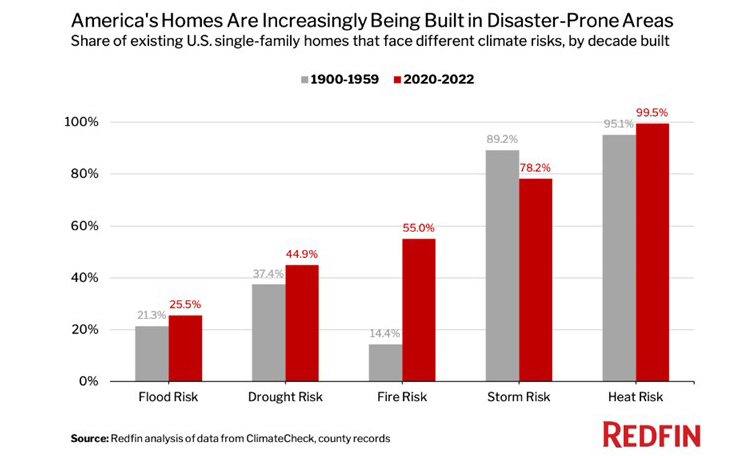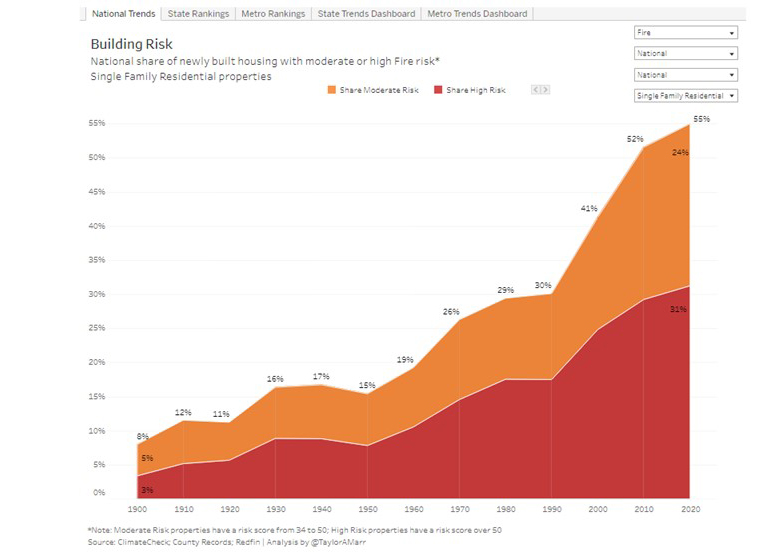
Home Building Increases in Disaster-Prone Areas

More than half of homes built today face fire risk, compared to 14% of homes built from 1900 to 1959, as suburbanization and a shift to the Sun Belt push builders into more vulnerable areas, said Redfin, Seattle.
The report said more than half (55%) of homes built so far this decade face fire risk, while 45% face drought risk. By comparison, just 14% of homes built from 1900 to 1959 face fire risk and 37% face drought risk. New homes are also more likely than older homes to face heat and flood risk, but the gap is largest when it comes to fire and drought.

The Redfin analysis looked at climate-risk scores from ClimateCheck and county records on single-family homes built since 1900 that still stand today. Redfin defines an at-risk home as one with a ClimateCheck score of moderate, high, very high or extreme. The analysis does not include homes with relatively low scores, which may also face some level of risk.
Overall, heat is the most common danger, with nearly 100% of homes constructed in the last two years at risk. Heat risk is based on the number of extremely hot days expected in the future. Next comes storm (78%), followed by fire (55%), drought (45%) and flood (25%). Storm is the only risk more likely to plague older homes. That’s likely because many of the country’s old homes are located in the storm-prone Northeast.
From an environmental standpoint, America is building, rebuilding and subsidizing homes in the wrong places, according to Jenny Schuetz, economist with the Brookings Institution, Washington, D.C., who recently published a book on the topic.
“The areas that are already built are at lower risk of wildfire because they’re not surrounded by forest and trees—they’re surrounded by other buildings,” Schuetz said. But “increasingly, we have to build new housing farther and farther out from downtown areas because the easy-to-use land has been built out and it’s often difficult to add more housing in the urban core.”
In the West, Scheutz said, “wildfire-prone areas are in the undeveloped lands, and so the farther we push toward the undeveloped lands, the more houses are going to be at risk.”
A 2021 Redfin analysis found that more people have been moving into than out of the U.S. counties with the largest share of homes at high risk of natural disasters. Many of these areas are attracting homebuyers because they’re relatively affordable, have lower property taxes, more housing options or access to nature. Some buyers also just aren’t aware of the risks.
The report noted while new homes are increasingly being built in disaster-prone areas, most of America’s housing stock is not new. Two-thirds of U.S. homes were built before 1990, while about 4% were built in 2014 or later, according to U.S. Census Bureau estimates.
However, the share of homes constructed in fire-prone areas has been steadily increasing since the 1960s as builders have expanded beyond dense cities and into areas with more flammable vegetation. More than half (55%) of homes built so far this decade face fire risk, compared with 19% of homes built in the 1960s and 8% of homes built from 1900 to 1910.

“There’s no room left to build in Salt Lake City, so developers have been moving into the surrounding mountains, which are more prone to wildfires and drought. Record-breaking temperatures and a lack of snow have turned these areas into tinder boxes,” said local Redfin Market Manager Ryan Aycock. “Herriman—a city just south of Salt Lake City that’s right up against the mountains—is attracting tons of builders. Fires were never that big of an issue when Herriman was mostly vacant land, but now scores of people are moving into harm’s way.”
A fire in 2010 burned more than 4,000 acres and destroyed several homes in the Herriman area after the National Guard conducted gun training despite fire and wind warnings. Nearly 40% of all Utah homes (roughly $220 billion worth) face high fire risk—a larger share than any other Western state Redfin analyzed in 2021.
Not only is America increasingly building homes in fire-prone areas—fires are also increasing in intensity. The three most destructive wildfire years, in terms of acreage burned, have all occurred in the past decade, according to the National Interagency Fire Center.
In Colorado, 90% of homes built so far this decade face fire risk, compared to just 23% of those built from 1900 to 1959. That 66-percentage-point gap is the largest among the states Redfin analyzed. Next comes Arizona (97% vs 38%), followed by Utah (85% vs 28%), California (91% vs 39%) and Florida (58% vs 6%).
A significant portion of America’s homebuilding is happening in Florida, California, Arizona and Colorado. Florida has issued 133,000 building permits so far this year, more than every state but Texas. California ranks third with 72,000 permits, while Arizona and Colorado rank sixth and seventh, at 40,000 and 33,000, respectively. That’s in part because these states continue to grow. Florida, Arizona and Utah all rank in the top 10 when it comes to percentage growth in population from 2020 to 2021, according to Census estimates.
Redfin reported the share of homes constructed in drought-prone areas has also been rising. Just under half (45%) of homes built so far this decade face drought risk, compared with 39% of homes built in the 1960s and 28% of homes built from 1900 to 1910.
One reason newer homes are more likely to face drought risk is they’re likely to be located in drought-prone states like Texas, California and Arizona. And within those drought-prone states, homes are increasingly being built in neighborhoods that aren’t equipped to handle drought.
“Homebuilding has exploded in Arizona over the last few years as our population has soared. Builders are going to the more rural, drought-prone areas because that’s where there’s available land,” said Phoenix Redfin real estate agent Heather Mahmood-Corley. “In Casa Grande—a city just south of Phoenix—builders are selling homes despite warnings that there may not be enough water to go around. In the nearby San Tan Valley, one developer owns a lot of the wells, so they’re able to build unrestricted and sell water rights to other developers.”
In Arizona, 75% of homes built this decade face drought risk, compared with 41% of those built from 1900 to 1959. That 34-percentage-point gap is the largest of any state Redfin analyzed. Next comes Pennsylvania (56% vs 28%), Nevada (86% vs 61%), Missouri (29% vs 6%) and Idaho (75% vs 54%).
